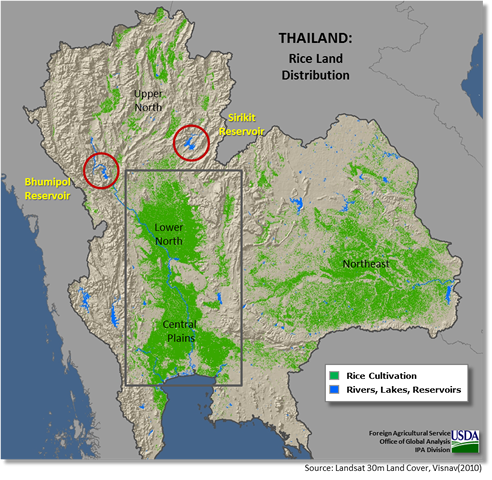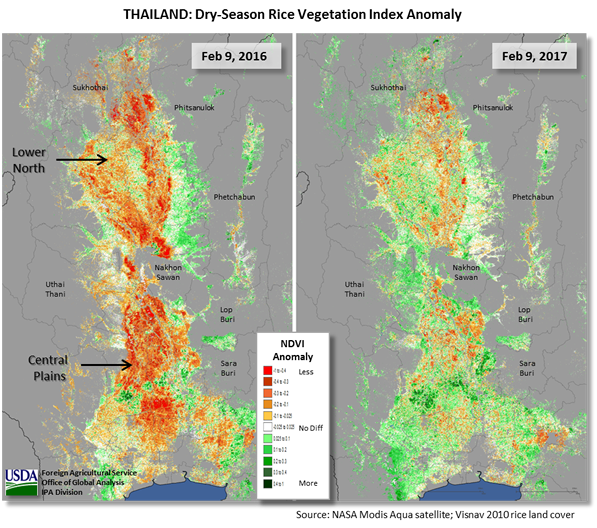THAILAND: Rice Production Rebounds Following El Nino
Thailand recovered in 2016 from a severe two-year El Niño-related drought, which had substantially reduced irrigation supplies and rice acreage in the country. Bountiful rainfall during the recent wet season replenished important reservoirs which supply the agricultural sector and enabled the government to lift restrictions on irrigated rice acreage during the 2016-17 dry season (November through May). Farmers responded by increasing rice acreage by an estimated 975,000 hectares compared to last year. Thailand’s 2016/17 harvested rice area is estimated at 10.1 million hectares, unchanged from last month but up 7 percent from last year. Production is currently forecast by USDA at 18.6 million metric tons (milled basis), up 18 percent from last year. Rough rice yield is estimated slightly above average at 2.80 tons per hectare.

Thailand has two annual rice-growing periods, the wet-season and the dry-season. The wet- season rice harvest is the larger of two annual crops, normally accounting for roughly 70 percent of total annual production. Wet-season rice acreage has averaged about 8.8 million hectares since 2007. Wet-season rice is heavily dependent on monsoonal weather systems, with 70 percent of the crop being totally rainfed. The remaining 30 percent lies primarily in the western Chao Phraya river basin and is irrigated from water stored in mountain reservoirs.
Dry-season rice area averages 2.0 million hectares, is approximately 80 percent irrigated, and accounts for roughly 30 percent of total annual rice production. Dry-season rice yield is nearly double the yields of the primarily rainfed wet-season crop. Dry-season rice cultivation is heavily focused on irrigated farmland in the Lower North and Central Plains regions. With the majority of the irrigation infrastructure and agricultural mechanization, these areas are essentially the nation’s rice heartland. The country’s annual exportable rice surplus is produced here, typically flowing from the dry season harvest itself. There are two major reservoirs which account for 80 to 90 percent of the irrigation supply for rice cultivation, Bhumipol and Sirikit, which are located in the northern headwaters of the Chao Phraya river basin. According to a report from the U.S. agricultural counselor in Bangkok, total reservoir supplies in the country were nearly 150 percent above those recorded this same time last year.

The key driver for the rebound in Thailand’s 2016/17 rice production was above-normal rainfall during the 2016 wet season (May through October). As can be seen in the maps above, abundant rainfall blanketed the core northern and northeast watersheds which feed the mountain reservoirs important to rice cultivation. The regional rainfall pattern significantly improved relative to 2015 all across Southeast Asia as the strong El Niño event waned in the Pacific. Given the replenishment of key reservoirs and irrigation supply in northern Thailand, the Thai government lifted restrictions on winter dry-season rice cultivation in October 2016 and allowed the Royal Irrigation Department (RID) to supply farmers with all the water they required. The RID reported in early February that farmers had more than doubled rice acreage compared to last year and that plantings would continue through February.

Recent MODIS satellite imagery data confirmed the government projection, showing a remarkable recovery in crop acreage and vegetative vigor compared to last year in the heart of the primary dry-season growing regions (Lower North and Central Plains). The normalized difference vegetation index (NDVI) shows that current crop development in February 2017 is better than average in most dry-season rice producing regions. By comparison, in February 2016 rice acreage had shrunk to a 20-year low, with NDVI data clearly indicating extremely low crop vegetation relative to the long-term norm for that time of year. The lack of irrigation supply had reduced dry-season rice acreage in February 2016 to an estimated 735,000 hectares. Given the substantial improvement in irrigation supply, 2016/17 dry-season rice acreage will likely increase approximately 133 percent compared to last year. As a result, dry-season rice production is forecast near the 5-year average.

This report has been published by the Office of Global Analysis (OGA), International Production Assessment Division (IPAD). Current USDA area and production estimates for grains and other agricultural commodities are available on IPAD's Agricultural Production page or at PSD Online.
Visit Crop Explorer http://www.pecad.fas.usda.gov/cropexplorer/
|

